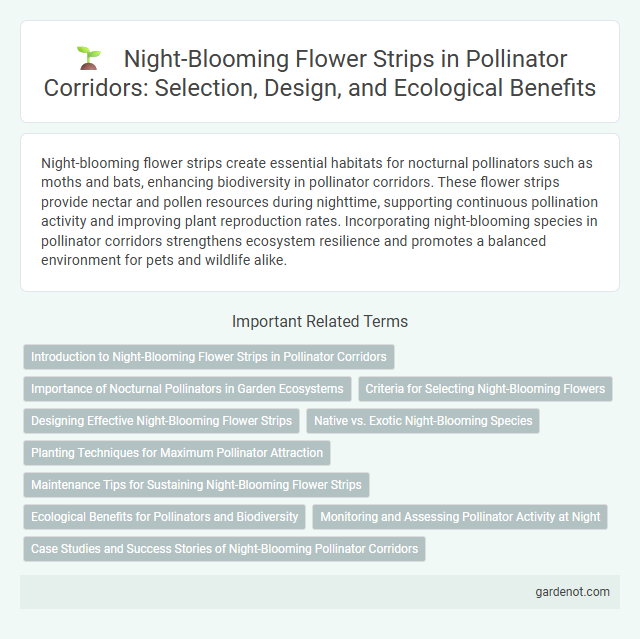Night-blooming flower strips create essential habitats for nocturnal pollinators such as moths and bats, enhancing biodiversity in pollinator corridors. These flower strips provide nectar and pollen resources during nighttime, supporting continuous pollination activity and improving plant reproduction rates. Incorporating night-blooming species in pollinator corridors strengthens ecosystem resilience and promotes a balanced environment for pets and wildlife alike.
Introduction to Night-Blooming Flower Strips in Pollinator Corridors
Night-blooming flower strips are critical components of pollinator corridors, providing essential nectar and pollen resources during nighttime hours for moths, bats, and other nocturnal pollinators. These strips typically include species such as evening primrose, night-blooming jasmine, and moonflower, which emit strong fragrances and produce large, pale flowers to attract and guide pollinators in low-light conditions. Integrating night-blooming flowers into pollinator corridors enhances biodiversity, supporting the survival of specialized pollinators and promoting healthy ecosystem functions.
Importance of Nocturnal Pollinators in Garden Ecosystems
Night-blooming flower strips provide critical habitats that support nocturnal pollinators such as moths, bats, and beetles, which play essential roles in garden ecosystems by facilitating the pollination of various plant species during nighttime hours. These nocturnal pollinators contribute to biodiversity and enhance plant reproductive success, thereby sustaining ecosystem services like fruit and seed production. Incorporating night-blooming flowers into garden designs promotes pollinator diversity and resilience, ensuring continuous pollination beyond daylight periods.
Criteria for Selecting Night-Blooming Flowers
Selecting night-blooming flowers for a pollinator corridor requires prioritizing species with strong nocturnal fragrance and abundant nectar production to attract moths and bats. Native plants such as evening primrose (Oenothera biennis) and moonflower (Ipomoea alba) thrive in low-light conditions and support local ecosystems effectively. Soil compatibility, bloom period alignment with pollinator activity, and resistance to local pests are also critical factors for ensuring a sustainable and vibrant night-blooming flower strip.
Designing Effective Night-Blooming Flower Strips
Designing effective night-blooming flower strips requires selecting plant species that attract nocturnal pollinators such as moths and bats, emphasizing strong fragrances and white or pale-colored blossoms to enhance visibility in low light. Strategic placement along pollinator corridors ensures connectivity between habitats, promoting genetic diversity and ecosystem resilience. Incorporating native night-blooming plants like evening primrose (Oenothera spp.) and moonflower (Ipomoea alba) optimizes pollination efficiency and supports local biodiversity.
Native vs. Exotic Night-Blooming Species
Night-blooming flower strips provide critical nectar and pollen sources for nocturnal pollinators like moths and bats. Native night-blooming species such as evening primrose and night jasmine support local ecosystems with specialized pollinator relationships, whereas exotic species may disrupt these interactions by attracting non-native pollinators or competing for resources. Selecting native night-blooming plants enhances biodiversity and resilience in pollinator corridors by preserving established ecological networks.
Planting Techniques for Maximum Pollinator Attraction
Plant night-blooming flower strips using dense clusters to create visual and olfactory cues that attract nocturnal pollinators such as moths and bats. Select native species with high nectar production and stagger bloom times to ensure continuous food sources throughout the pollination season. Incorporate companion plants with complementary floral traits and avoid pesticide use to maximize pollinator visitation and enhance biodiversity in the corridor.
Maintenance Tips for Sustaining Night-Blooming Flower Strips
Maintaining night-blooming flower strips requires regular watering during dry periods, ensuring soil remains moist but well-drained to support pollinator activity. Pruning spent blooms encourages continuous flowering, enhancing nectar availability for nocturnal pollinators like moths and bats. Avoiding chemical pesticides and using organic mulch helps preserve soil health and sustains a thriving pollinator corridor.
Ecological Benefits for Pollinators and Biodiversity
Night-blooming flower strips provide essential nectar and pollen resources for nocturnal pollinators such as moths, bats, and certain beetles, supporting their foraging activities and survival. These flower strips enhance biodiversity by promoting a diverse range of pollinator species and facilitating cross-pollination, which improves plant reproduction and ecosystem resilience. Integrating night-blooming plants into pollinator corridors strengthens ecological networks and contributes to sustained habitat connectivity across landscapes.
Monitoring and Assessing Pollinator Activity at Night
Monitoring and assessing pollinator activity at night within a night-blooming flower strip involves using specialized infrared cameras and acoustic sensors to capture nocturnal pollinators such as moths and bats. Data collected includes species identification, visitation frequency, and pollination behavior, which are analyzed to evaluate the effectiveness of the corridor in supporting biodiversity. Continuous remote monitoring enables researchers to track temporal activity patterns and adapt conservation strategies for enhancing night-time pollinator habitats.
Case Studies and Success Stories of Night-Blooming Pollinator Corridors
Case studies of night-blooming pollinator corridors highlight significant increases in populations of nocturnal pollinators such as moths and bats, contributing to enhanced biodiversity and crop yields. Successful implementation in regions like California and Costa Rica demonstrated a 30% rise in native moth species and improved pollination rates for plants like evening primrose and moonflower. These corridors, by connecting fragmented habitats, foster resilient ecosystems and support sustainable agricultural practices.
Night-blooming flower strip Infographic

 gardenot.com
gardenot.com